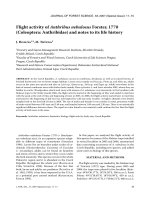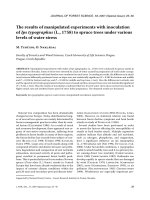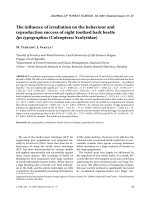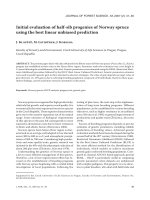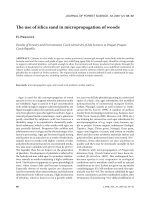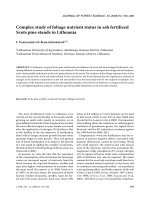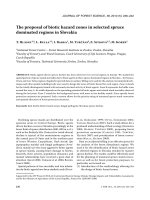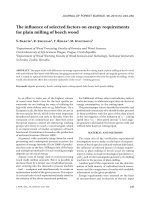Báo cáo lâm nghiệp: "Direct sowing of holm oak acorns: effects of acorn size and soil treatment" ppsx
Bạn đang xem bản rút gọn của tài liệu. Xem và tải ngay bản đầy đủ của tài liệu tại đây (1.02 MB, 7 trang )
Ann. For. Sci. 63 (2006) 961–967 961
c
INRA, EDP Sciences, 2006
DOI: 10.1051/forest:2006079
Original article
Direct sowing of holm oak acorns: effects of acorn size
and soil treatment
Francisco Bruno N
a
*
, María Noelia J
´
a
, María Ángeles R
a
,
Emilia F
´
-O
˜
b
, Eduardo G
a
, Estanislao D S
´
a
a
Grupo de Sistemas Forestales, Área de Recursos Naturales, Centro de Investigación y Formación Agraria, Instituto Andaluz de Investigación y
Formación Agraria, Pesquera, Alimentaria y de la Producción Ecológica (C.I.C.E., Junta de Andalucía), Camino de Purchil s/no,
Aptdo. 2027, 18080 Granada, Spain
b
Departamento de Edafología y Química Agrícola, Facultad de Ciencias, Universidad de Granada, C/Severo Ochoa s/no. 18071 Granada, Spain
(Received 14 February 2006; accepted 27 June 2006)
Abstract – A nursery experiment under optimal controlled conditions and a parallel field trial under conditions of severe water stress were conducted to
test the influence that acorn size and soil preparation (only in field) exert on the survival and development of this species. The soil preparation consisted
of preparing seed beds with a backhoe. The size and weight of the acorn were the factors that most controlled the development of this species in the
nursery, while in the field, under conditions of water stress, only acorn weight was related negatively to the root:shoot ratio. Water availability was
also found to be a strongly limiting factor for plant development, when the results of the two experiments were compared. In the field, the prior soil
preparation negatively affected survival (65%) with respect to control (95%), RCD and R/S ratio. In conclusion, given the low precipitation during
the study period and the low survival results reported by other researchers with the introduction of seedlings, even in higher-rainfall localities, sowing
acorns directly in the field should be reconsidered as a viable technique for restoring holm oak forests, for forestation on agricultural lands, or the
diversification of forest species on a large scale at low costs.
Quercus ilex subsp. ballota / acorn / soil treatment / abandoned agricultural land
Résumé – Semis directs des glands de chênes : effet de la grosseur des glands et du traitement du sol. Un essai en pépinière en conditions
contrôlées optimales et un autre essai en plein champ en conditions de stress hydrique sévère pour le chêne ont été menés pour tester l’influence que
la grosseur des glands et la préparation du sol (seulement au champ) exercent sur la survie et le développement de cette espèce. La préparation du sol
a consisté en un poquet réalisé avec un retroexcavateur. La grosseur et le poids du gland ont été les facteurs qui ont provoqué le développement plus
important de cette espèce en pépinière. Néanmoins, en plein champ, dans des conditions de stress hydrique seul le poids du gland a permis d’établir une
corrélation négative avec le rapport racine/pousse. La disponibilité en eau a été un facteur extrêmement limitant pour le développement des plants, si on
compare les résultats des deux expérimentations. Au champ, la préparation du terrain a influencé d’une manière négative la survie (65 %) par rapport au
témoin (90 %), au diamètre des plants et au rapport racine/pousse. En conclusion, compte tenue des faibles pluies tombées pendant la période d’étude et
des résultats de faible survie obtenus par d’autres auteurs avec l’introduction de semis, même dans des régions de pluviométrie plus abondante, le semis
direct de glands au champ doit être repensé en tant que technique viable pour la restauration des forêts de chêne, le reboisement des terres agricoles et
la diversification à grande échelle des espèces forestières et à moindre coût.
Quercus ilex subsp. ballota / gland / traitement du sol / terre agricole abandonnée
1. INTRODUCTION
The holm oak (Quercus ilex L. subsp. ballota (Desf.)
Samp.) is one of the most representative species in the for-
est communities of the Mediterranean basin [35], especially
on the Iberian Peninsula, where it forms part of the vegeta-
tion (existing as well as potential) in extensive areas [18, 39].
The use of this evergreen sclerophilous tree in reforestation
programs on abandoned agricultural lands promoted by the
Common Agricultural Policy (CAP) has strongly increased in
the last 12 years, in contrast to the Pinus species, which were
widely used in the past [47]. Only in Andalusia (Spain), more
* Corresponding author:
than 75 000 ha were reforested from 1993 to 1999, implying
the introduction of millions of new seedlings.
Nevertheless, forestation with the holm oak presents sur-
vival difficulties and low growth rates in comparison to other
Mediterranean tree or shrub species [1, 2], and more so the
stronger the stress factors during the first developmental stage
in the field. It is widely known that the first Mediterranean
summer after planting is the most critical period for the sur-
vival of this species due to high temperatures, excessive so-
lar radiation, and low water availability [21, 33, 45]. These
difficulties accentuate within the limits of the distribution of
this species, whether for climatic dryness (semiarid habitats
Pp < 350 mm) or for the lack of soil, poor water-retention ca-
pacity of the soil, or unfavourable exposures.
Article published by EDP Sciences and available at or />962 F.B. Navarro et al.
Some authors propose that the poor performance of foresta-
tion stands of Q. ilex subsp. ballota could be attributed to the
low quality of seedlings used, as the cultivation regime in the
nursery can strongly determine functional characteristics and
response of the seedling in the field [47]. However, the high
mortality rates of reforested seedlings in localities where there
is even a vigorous natural regeneration suggest that not only
the type of holm oak seedling commonly used in forestation
but also the technique of introducing this species into the field
should be reviewed.
Therefore, a large portion of recent forest research in the
Mediterranean basin has focussed on finding alternative meth-
ods of planting species of the genus Quercus, especially the
holm oak (Q. ilex subsp. ballota) and the cork oak (Q. suber).
These studies have centred fundamentally on enhancing the
quality of nursery seedlings [11, 47], improving planting tech-
niques [2, 37, 44], and finding effective post-planting treat-
ments [17,26, 34,41, 42].
On the other hand, little attention has been given to foresta-
tion by sowing acorns directly in the field. In Mediterranean
environments, one of the variables that can increase the prob-
ability of survival is the access to soil water during summer,
which can be achieved with a stronger root system and/or a
deeper one [46]. Therefore, the growth rate of the root dur-
ing the first months of life (winter-spring) can be crucial to
the survival of the seedling over the dry season [20]. A deep
tap root is one of the main strategies of the holm oak seedling
for survival during the early establishment phase, making di-
rect sowing of the acorn an attractive alternative to plant-
ing seedlings, with the added advantage of being a low-cost
method. In this sense, some authors warn of the possible nega-
tive effects caused by the deformation of the roots of container-
grown holm oak [15].
Some direct-sowing trials of acorns have shown very
uneven survival results with respect to the planting of
seedlings [5, 27, 31, 37], perhaps due to the origin and sizes
of the acorns used, the ways of collecting and storing the
acorns, pre-germination treatments, conditions of the sowing,
climatology of the year of planting, the interference of seed
predators, etc. Few works clarify these issues in sowing exper-
iments. Along these lines, Castro et al. [7] note that the effect
of seed size upon seedling performance can be easily confused
with the effect exerted by the genetic determination of the ma-
ternal plant when the experiments are performed with mixed
groups of genotypes. Therefore, new experiments controlling
all these variables need to be performed.
The present work examines in detail some factors that can
affect the rooting of holm oak seedlings after direct sowing of
the acorns, such as acorn size and pre-sowing soil preparation.
2. MATERIALS AND METHODS
In autumn 2002 (early November), acorns of different sizes but
from the same tree were collected in the north of the province of
Granada (Guadix plateau, S Spain). Healthy acorns without appar-
ent defects were numbered, measured for length and diameter (mm),
and weighed (g). Then they were stratified in wet sand at 4
◦
Cto
Table I. Biometric characteristics of the acorns used in the field ex-
periment (n = 40).
Mean SE Min. Max.
Diameter (mm) 17.66 0.16 15.29 20.36
Length (mm) 42.25 0.27 37.62 45.75
Weight (g) 8.02 0.16 5.41 9.93
stimulate germination. A total of 20 acorns were used in the nursery
experiment, and 40 in the field experiment.
2.1. Nursery experiment
The 20 acorns selected were classified into two significantly
distinct groups according to size (Small acorns: diameter (mm) =
16.33±0.31a, length (mm) = 38.80 ±1.03a, weight (g) = 6.24±0.37a;
Large acorns: diameter = 22.20 ± 0.33b, length = 43.57 ± 1.10b,
weight = 12.58 ± 0.39b; different letters indicate different signifi-
cances at 95% confidence level [one-way ANOVA, Tukey test]) and
sown (pre-germinated) at 5 cm deep on 18 December 2002 in PVC
cylinders (180 cm tall, 25 cm in diameter) filled with nursery sub-
strate consisting of 2/3 peat and 1/3 perlite. These tubes were situated
in the open air at the Centre for Agricultural Research and Training
of Granada (S Spain), where, apart from rainfall, the tubes received
periodic watering to provide the seedling constant available moisture,
which was controlled by a Watermark
tensiometer situated at 90 cm
in depth (middle of the tube).
The seedlings were measured for height (cm), diameter at the root
collar (RCD, mm), and the number of leaves in July and October 2003
as well as in February and November of 2004.
This type of container was used to analyse the root system of the
plants at the end of the study period [(tap-root length, biomass of
secondary roots (> 2 mm diameter, GB), biomass of the hair roots
(< 2 mm diameter, FB), and biomass of the total root system (RB)].
Also, the biomass of the stems (SB), leaves (LB), and total-shoot
biomass (AB) was measured, as well as the root:shoot ratio (R:S),
and total weight (TB = AB + RB). This destructive analysis was per-
formed in November 2004, two years after the controlled cultivation
in the nursery.
2.2. Field experiment
Of the 40 acorns selected for the field trial (Tab. I), half were taken
at random and sown at 5 cm in depth without prior soil preparation.
The other half were sown at the same depth but in beds prepared by a
backhoe with a small blade (70 ×35× 50 cm), in a complete, random-
ized block. The acorns were sown in the open on 19 December 2002,
on 5×5 m centres, one day after the nursery sowing. The acorns were
also sown pre-germinated and each was protected from seed preda-
tors with a cylinder of wire mesh.
With respect to sowing with vs. without prior soil preparation, no
significant differences (one-way ANOVA) were found in the initial
characteristics of the acorns (length: F
(1,39)
= 1.29, P = 0.9261;
diameter: F
(1,39)
= 1.10, P = 0.3046; weight: F
(1,39)
= 0.44, P =
0.5109).
Direct sowing of holm oak acorns 963
This experiment was made in the Altiplano del Conejo of Guadix
in the province of Granada (S Spain) at 1 000 m a.s.l. The mean an-
nual precipitation is 304 mm, with marked irregularity (Pp (mm):
October 2002–2003 = 302.1, October 2003–2004 = 363.4, Octo-
ber 2004–2005 = 167.7) and extreme temperatures, summer reaching
43.4
◦
C (August 2003) and winter –17
◦
C (January 2003). The bio-
climatic level of this zone is semiarid mesomediterranean [36]. The
soil is a petric calcisol [12] with a pH of 7.2 to 8.5, of loamy-sandy
clay. The land, homogeneous abandoned agricultural land with scat-
tered holm oaks, was traditionally dedicated to cereal until the activity
stopped in 1993 when the government bought the lands.
These seedlings were monitored for survival, height, and RCD in
October 2003, February and July of 2004, and July of 2005. In July
2005, 16 saplings were uprooted, eight per treatment (control, soil
treatment) to be measured for length of the tap root, LB, SB, FB, GB,
AB, RB, R:S and TB. Also, soil samples were taken at 0–20, 20–30
and 30–40 cm in depth, both in unprepared soil as well as in the beds
prepared by the backhoe. Analyses were made of the gravel content as
well as CaCO
3
,N,P,K,Na,Mg,Cu,Mn,FeandZnconcentrations.
The following were also determined: total N, by Kjeldahl method;
exchangeable cations (Ca, Mg, K, Cu, Mn, Fe and Zn) by extraction
with 1N ammonium acetate (pH 7.0) [8]; available P, by the classi-
cal Olsen method [28], and the CaCO
3
equivalent, by a manometric
method [48].
2.3. Data analyses
The data on height, RCD, and number of leaves in the nursery
experiment were analysed separately for each sampling period, by a
one-way ANOVA (acorn size factor). Similarly, the height and RCD
data from the field were analysed for the factor “soil treatment”.
The length of the tap root, LB, SB, FB, GB, AB, RB, R:S and
TB, measured only at the end of the study period, both in the nurs-
ery as well as in the field experiment, were analysed also by a one-
way ANOVA. The Tukey HSD test of all-pairwaise comparisons was
run in all cases. Normality was checked by the Shappiro-Wilk test,
and homogeneity by the Bartlett test. In the case of violation of vari-
ance equality, the nonparametric test of Kruskal-Wallis was used. The
Pearson correlation was used to analyse the relationship between the
initial characteristics of the acorns and the characteristics of the re-
sulting plants. Field survival of seedlings was analysed by the Kaplan
and Meier logrank test.
All statistical analyses were performed using the STATIS-
TIX 8 (Analytical Software, Tallahassee, USA), except for survival,
which was analysed with STATGRAPHICS Plus 4.0 (Manugistics,
Rockville, USA).
3. RESULTS
3.1. Nursery experiment
In the nursery, acorn size significantly influenced the vari-
ables measured. The larger acorns produced taller plants with
a greater number of leaves, and greater RCD from the first
sampling to the end of the study period (Fig. 1). Similarly,
after the final destructive analysis, the larger acorn lot gave
rise to higher values for AB (F
(1,19)
= 36.9, P = 0.0000), RB
(F
(1,19)
= 24.0, P = 0.0002), GB (F
(1,19)
= 24.7, P = 0.0002),
Figure 1. Evolution of height, RCD, and number of leaves of the
holm oak nursery-cultivated seedlings in relation to the size of the
acorn. * 0.05 > P > 0.01, ** 0.01 > P > 0.001, *** P < 0.001
(Tukey HSD all-pairwaise comparisons test).
SB (F
(1,19)
= 32.9, P = 0.0000), LB (F
(1,19)
= 28.8, P =
0.0001) and TB (F
(1,19)
= 32.5, P = 0.0000). However, no
significant differences were found with respect to FB, R:S ra-
tio, or tap-root length, which reached a mean of 1.46 ± 0.10 m
in depth. A significant positive correlation was established be-
tween acorn size and most of the morphological variables of
the plants after 24 months of growth (Tab. II).
964 F.B. Navarro et al.
Table II. Results of the Pearson correlation analysis of the biometric characteristics of the nursery-sown acorns and the characteristics of the
resulting plants after two years of cultivation (n = 20). r = Pearson correlation coefficient, P = P-value, AB = shoot biomass, RB = total
root biomass, GB = secondary-root biomass (> 2 mm), SB = stem biomass, LB = leaf biomass, TB = Total biomass; * 0.05 > P > 0.01,
** 0.01 > P > 0.001, *** P < 0.001.
No. leaves AB (g) RB (g) Height (mm) GB (g) SB (g) TB (g) LB (g)
Acorn diameter (mm) r 0.5420 0.7181 0.7248 0.6459 0.7246 0.6917 0.7378 0.7043
P 0.0246* 0.0012** 0.0010** 0.0051** 0.0010** 0.0021** 0.0007*** 0.0016**
Acorn length (mm) r 0.5612 0.7189 0.7115 0.6176 0.7069 0.7073 0.7303 0.6908
P 0.0191* 0.001** 0.0014** 0.0083** 0.0015** 0.0015** 0.0009*** 0.0021**
Acorn weight (g) r 0.5989 0.7827 0.7928 0.7057 0.7903 0.7641 0.8058 0.7579
P 0.0111* 0.002** 0.0001*** 0.0016** 0.0002*** 0.0004*** 0.0001*** 0.0004***
Figure 2. Evolution of the RCD of the holm oaks sown in the field in
relation to the prior soil treatment made. * 0.05 > P > 0.01, ** 0.01 >
P > 0.001, *** P < 0.001 (Tukey HSD all-pairwaise comparisons
test).
3.2. Field experiment
Of the 40 pre-germinated acorns sown at the Altiplano del
Conejo in December 2002, 32 survived to July 2005 (80%).
Survival, with respect to control (95%), was lower for the
acorns sown with prior soil preparation (65%, χ
2
= 5.60,
P = 0.017). It was also found that seedling survival was
independent of acorn size and weight (Kruskal-Wallis test,
P > 0.05).
In relation to seedling characteristics, only RCD and R/S
ratio were significantly affected by the factor analysed. Soil
preparation did not encourage growth of the RCD with respect
to control from the outset of the study (Fig. 2), and the plants
with prior soil preparation invested less in root biomass in re-
lation to aboveground biomass than did control plants (Fig. 3).
No significant correlation was found between the biometric
parameters of the acorns and the morphological attributes of
the resulting seedlings, except for R:S, which correlated nega-
tively with acorn weight (Fig. 4).
The soil preparation homogenized the characteristics of the
pedological profile, as can be appreciated in Table III. The
CaCO
3
content, which in the unaltered soil increased in depth,
Figure 3. Root:Shoot allocation in relation to the prior soil treatment
made. Different letters indicate the significant differences at 95% con-
fidence level.
Figure 4. Root:Shoot allocation in relation to the weight of the acorns
sown at the Altiplano del Conejo 32 months before. r = Pearson cor-
relation coefficient, P = P-value.
increasing on the surface of the prepared soil, the trend being
the opposite with P and K.
3.3. Comparing nursery and field plants
Although the nursery plants were harvested after 24 months
of growing and the plants cultivated in the field were har-
vested after 32 months, the development of the size and weight
Direct sowing of holm oak acorns 965
Table III. Characteristics of the pedological profile of the untreated soil (control) and in the planting beds prepared with the backhoe (soil
treatment).
Depth gravels N P CaCO
3
Na K Mg Cu Mn Fe Zn
Treatment cm % % µg.g
−1
%Cmol
c
kg
−1
µg.g
−1
Control 0–20 36.8 0.12 17.64 18.8 0.10 0.27 0.52 nd 0.53 0.07 nd
20–30 46.4 0.14 12.24 36.5 0.10 0.12 0.51 nd 0.17 0.14 nd
30–40 55.7 0.13 9.91 49.2 0.10 0.12 0.51 nd 0.20 0.12 nd
Soil treatment 0–20 50.0 0.10 9.50 46.1 0.08 0.15 0.53 nd 0.26 0.06 nd
20–30 40.0 0.11 12.65 41.9 0.08 0.18 0.53 nd 0.35 0.08 nd
30–40 52.5 0.10 14.65 38.8 0.10 0.15 0.53 nd 0.31 0.11 nd
Figure 5. Comparative graph for development in mean size and
weight of the nursery-sown plants (grey) harvested at 24 months, and
those cultivated in the field (black) harvested at 32 months.
of the nursery-grown plants was far greater (Fig. 5). Simi-
larly, the nursery plants had a more balanced R:S ratio (small
acorns = 1.30 ± 0.08a; large acorns = 1.31 ± 0.09a) than did
those grown in the field (control = 3.22 ± 0.32a; prior soil
preparation = 2.09 ± 0.36b).
4. DISCUSSION
Under optimal water conditions in the nursery, the larger
or heavier acorns produced significantly more vigorous
seedlings, a result widely supported, not only in the genus
Quercus [16,25,30]. Furthermore, it is established (for an ex-
ception, see [14]) that large seeds result in higher seedling sur-
vival [3, 10,20].
However, in the field experiment at the Altiplano del
Conejo, under water-stress conditions, there was far less plant
development (Fig. 5) and no relationship was found between
acorn size or weight and survival or morphological character-
istics of the plants over 32 months of development. This coin-
cides with the results of Marañón et al. [23] that plant weight
(after 50 days of growth) was independent of initial weight of
the acorn for three Quercus species (see [22,46]). In this sense,
some authors [6, 24,38] indicate that this positive relationship
between seed weight and seedling growth may be restricted
only to the first weeks or months after emergence, disappear-
ing later during seedling development.
Only acorn weight negatively correlated with the root:shoot
ratio (Fig. 4), this occurring only in the field experiment. This
contrasts with the results reported by Leiva and Fernández-
Alés [19] and Lloret et al. [20]. On the other hand, it coin-
cides with the findings of Valdecantos et al. [40,42] and Villar-
Salvador et al. [47], who found greater increases in shoot
biomass, in Q. ilex seedlings which were fertilized or were
grown in soil amended with organic matter, without detriment
to root weight.
In contrast to the results reported by Nicolás et al. [27]
with respect to sowing and planting of Q. ilex,aswellasby
Querejeta et al. [32] and Bocio et al. [2] regarding the plant-
ing of Q. ilex and Pinus halepensis Mill., soil preparation
with a backhoe did not favour growth or survival of the holm
oak with respect to those sown without preparation, but rather
the contrary; this fact may have been due to some change in
the soil properties caused by the soil preparation, such as in-
creased CaCO
3
content in the uppermost horizon coming from
a deeper petrocalcic horizon (Tab. III). It has been confirmed
that high CaCO
3
concentrations in the soil solution can affect
the germination and growth of seedlings, because they inter-
fere in P and K assimilation [29, 43]. In this sense, further re-
search is needed.
Although Q. ilex is considered a shade-tolerant species in
which the recruitment capacity falters when exposed to full
sun [4, 33] or at high temperatures [49], if sowing is well
planned (selected acorns, pre-germination treatments, protec-
tion against herbivores, mycorrhyzation, etc.), the survival can
966 F.B. Navarro et al.
reach very high levels. In the present study, the mean survival
in the field was 80% (95% in control plants). Given the low
precipitation during the study period and the low results re-
ported by other researchers with the introduction of seedlings,
even in higher-rainfall localities [9, 11, 13, 34], direct sowing
of acorns in the field should be reconsidered as a technique for
the restoration of holm oak forests, forestation of agricultural
lands, or the diversification of forest spaces on a large scale at
low cost.
Acknowledgements: This work was made possible by a predoctoral
grant financed by the Instituto Nacional de Investigación Agraria
(INIA) and a research grant financed by the system INIA-CCAA
(Spain). We are grateful to David Nesbitt for the linguistic review
of the English manuscript.
REFERENCES
[1] Baeza M.J., Pastor A., Martín J., Ibánez M., Mortalidad post-
implantación en repoblaciones de Pinus halepensis, Quercus ilex,
Ceratonia siliqua y Tetraclinis articulata en la provincia de
Alicante, Studia Oecol. 8 (1991) 139–146.
[2] Bocio I., Navarro F.B., Ripoll M.A., Jiménez M.N., De Simón E.,
Holm oak (Quercus rotundifolia Lam.) and Aleppo pine (Pinus
halepensis Mill.) response to different soil preparation techniques
applied to forestation in abandoned farmland, Ann. For. Sci. 61
(2004) 171–178.
[3] Bonfil C., The effects of seed size, cotyledon reserves, and her-
bivory on seedling survival and growth in Quercus rugosa and
Quer cus laurina (Fagacee), Am. J. Bot. 85 (1998) 79–87.
[4] Broncano M.J., Riba M., Retana J., Seed germination and seedling
performance of two Mediterranean tree species, holm oak (Quercus
ilex L.) and Aleppo pine (Pinus halepensis Mill.): a multifactor ex-
perimental approach, Plant Ecol. 138 (1998) 17–26.
[5] Carreras C., Sánchez J., Reche P., Herrero D., Navarro A., Navío
J.J., Primeros resultados de una repoblación mediante siembra con
protectores en Vélez-Rubio (Almería), Cuad. Soc. Esp. Cien. For. 4
(1997) 135–139.
[6] Castro J., Seed mass versus seedling performance in Scots pine: a
maternally dependent trait, New Phytol. 144 (1999) 153–161.
[7] Castro J., Hódar J.A., Gómez J.M., Seed size, in: Basra A.
(Ed.), Handbook of seed science and technology, Haworth’s Food
Products Press, New York, 2006, 796 p.
[8] Chapman H.D., Cation-exchange capacity, in: Blank C.A., Evans
D.D., White J.L., Ensminger L.E., Clark F.E. (Eds.), Methods of
soil analysis, Vol. II, American Society of Agronomy, Madison,
Wisconsin, 1965, pp. 891–901.
[9] Cortina J., Bellot J., Vilagrosa A., Caturla R.N., Maestre F.T., Rubio
E., Ortíz De Uurbina J.M., Bonet A., Restauración en semiárido, in:
Vallejo V.R. (Ed.), Avances en el estudio de la gestión del monte
Mediterráneo, Fundación CEAM, Valencia, España, 2004, pp. 345–
406.
[10] Dalling J.W., Hubbell S.P., Seed size, growth rate and gap mi-
crosite conditions as determinants of recruitment success for pio-
neer species, J. Ecol. 90 (2002) 557–568.
[11] Del Campo A.D., Navarro R., Stoktypes quality of holm oak
(Quercus ilex L. subsp. ballota (Desf.) Samp.) seedlings from dif-
ferent nurseries. Evaluation of field performance, Cuad. Soc. Esp.
Cien. For. 17 (2004) 35–42.
[12] FAO-ISRIC, Base referencial mundial del recurso del suelo, FAO,
Roma, 1998, 91 p.
[13] Fuentes D., Valdecantos A., Vallejo V.R., Planting Pinus halepensis
Mill. and Quercus ilex L. subsp. ballota (Desf.) Samp. seedlings in
dry Mediteranean environments with a water harvesting technique,
Cuad. Soc. Esp. Cien. For. 17 (2004) 157–161.
[14] Gómez J.M., Bigger is not always better: Conflicting selective pres-
sures on seed size in Quercus ilex, Evolution 58 (2004) 71–80.
[15] Gómez V., Ocaña L., Las marras causadas por defectos en las opera-
ciones de reforestación, Cuad. Soc. Esp. Cien. For. 4 (1997) 35–42.
[16] Jarvis P.G., The effects of acorn size and provenance on the growth
of seedlings of sessile oaks, Q. J. For. 57 (1963) 11–19.
[17] Jiménez M.N., Ripoll M.A., Navarro F.B., Bocio I., De Simón E.,
Modification of the edaphic microclimate produced by irrigation in
afforestation of semiarid areas, Invest. Agrar. Sist. Recur. For. Fuera
de serie (2004) 142–151.
[18] Jiménez-Sancho M.P., Díaz P., Iglesias S., De Tuero M., Gil L.,
Las regiones de procedencia de Quercus ilex L. en España, ICONA,
Madrid, España, 1996.
[19] Leiva M.J., Fernández-Alés R., Variability in seedling water status
during drought within a Quercus ilex subsp. ballota population, and
its relation to seedling morphology, For. Ecol. Manage. 111 (1998)
147–156.
[20] Lloret F., Casanovas C., Peñuelas J., Seedling survival of
Mediterranean shrubland species in relation to root:shoot ratio, seed
size and water and nitrogen use, Funct. Ecol. 13 (1999) 210–216.
[21] Maestre F.T., Cortina J., Bautista S., Bellot J., Vallejo V.H., Small-
scale environmental heterogeneity and spatio-temporal dynam-
ics of seedling establishment in a semi-arid degraded ecosystem,
Ecosystems 6 (2003) 630–643.
[22] Marañón T., Villar, R., Quero J.L., Pérez-Ramos I.M., Análisis del
crecimiento de plántulas de Quercus suber y Q. canariensis: exper-
imentos de campo y de invernadero, Cuad. Soc. Esp. Cien. For. 20
(2004) 87–92.
[23] Marañón T., Zamora R., Villar R., Zavala M.A., Quero J.L., Pérez-
Ramos I.M., Mendoza I., Castro J., Regeneration of tree species
and restoration under contrasted Mediterranean habitats: field and
glasshouse experiments, Int. J. Ecol. Environ. Sci. 30 (in press).
[24] Meyer S.E., Carlson S.L., Achene mass variation in Ericameria
nauseosus (Asteraceae) in relation to dispersal ability and seedling
fitness, Funct. Ecol. 15 (2001) 274–281.
[25] Miao S., Acorn mass and seedling growth in Quercus rubra in re-
sponse to elevated CO
2
, J. Veg. Sci. 6 (1995) 670–700.
[26] Navarro R., Fragueiro B., De Prado R., Díaz J.L., Guzmán R.,
Técnicas de conservación del suelo en forestaciones de terrenos
agrícolas, in: Fernández P., González E.J., Martínez A., Navarro R.
(Eds.), Mantenimiento y conservación del suelo en forestaciones
agrarias, Asociación Española Agricultura de Conservación/Suelos
Vivos-ETSI Agrónomos y de Montes, Universidad de Córdoba,
Córdoba, España, 2004, pp. 41–73.
[27] Nicolás J.L., Domínguez S., Herrero N., Villar P., Plantación y
siembra de Quercus ilex L.: efectos de la preparación del terreno
y de la utilización de protectores en la supervivencia de plantas,
Actas del II Congreso Forestal Español, vol. 3, 1997, pp. 449–454.
[28] Olsen S.R., Sommers L.E., Phosphorus, in: Page D.L. (Ed.),
Methods of Soil Analysis. Chemical and Microbiological
Properties, American Society of Agronomy and Soil Science
Society of America, Madison, USA, 1982, pp. 403–430.
[29] Papatheodoru E.M., Stamou G.P., Nutrient attributes of tissues in
relation to grazing in an evergreen sclerophyllous shrub (Quercus
coccifera L.) dominating vegetation in Mediterranean-type ecosys-
tems, J. Arid Environ. 59 (2004) 217–227.
[30] Paz H., Martínez-Ramos M., Seed mass and seedling performance
within eight species of Psychotria (Rubiaceae), Ecology 84 (2003)
439–450.
[31] Porras C.J., Brun P., Copete J., Pérez R., Studies on holm oak regen-
eration in Sevilla mountains, Cuad. Soc. Esp. Cien. For. 17 (2004)
223–226.
Direct sowing of holm oak acorns 967
[32] Querejeta J.I., Roldán A., Albadalejo J., Castillo V., The role of
the mycorrhizae, site preparation, and organic amendment in the af-
forestation of a semi-arid Mediterranean site with Pinus halepensis,
For. Sci. 44 (1998) 204–211.
[33] Retana J., Espelta J.M., Gracia M., Riba M., Seedling recruitment,
in: Rodà F., Retana J., Gracia C., Bellot J. (Eds.), Ecology of
Mediterranean evergreen oak forest, Springer-Verlag, Berlin, 1999,
pp. 89–103.
[34] Rey Benayas J.M., Growth and mortality in Quercus ilex L.
seedlings after irrigation and artificial shading in Mediterranean set-
aside agricultural lands, Ann. Sci. For. 55 (1998) 801–807.
[35] Reyes O., Casal M., Seed germination of Quercus robur, Q. pyre-
naica and Q. ilex and the effects of smoke, heat, ash and charcoal,
Ann. For. Sci. 63 (2006) 205–212.
[36] Rivas-Martínez S., Loidi J., Bioclimatology of the Iberian penin-
sula, Itinera Geobot. 13 (1999) 41–47.
[37] Seva J.P., Valdecantos A., Cortina J., Vallejo V.R., Different tech-
niques for afforestation with Quer cus ilex ssp. ballota (Desf.) Samp.
in degraded lands (Comunidad Valenciana), Cuad. Soc. Esp. Cien.
For. 17 (2004) 233–238.
[38] Smart A., Moser L.E., Switchgrass seedling development as af-
fected by seed size, Agron. J. 91 (1999) 335–338.
[39] Terradas J., Holm oak and holm oak forest: an introduction,
in: Rodà F., Retana J., Gracia C., Bellot J. (Eds.), Ecology of
Mediterranean evergreen oak forest, Springer-Verlag, Berlín, 1999,
pp. 3–14.
[40] Valdecantos A., Cortina J., Vallejo V.R., Respuesta de plantones de
pino carasco y encina carrasca a la fertilización, Cuad. Soc. Esp.
Cien. For. 10 (2000) 63–68.
[41] Valdecantos A., Cortina J., Fuentes D., Casanova G., Díaz-Beltrana
J.M., Lavador F., Vallejo V.R., Use of biosolids for reforestation in
the Region of Valencia (E Spain). First results of a pilot project,
Bioprocessing Solid Waste Sludge 1 (2002) 1–6.
[42] Valdecantos A., Fuentes D., Cortina J., Utilización de biosólidos en
la restauración forestal, in: Vallejo V.R. (Ed.), Avances en el estudio
de la gestión del monte Mediterráneo, Fundación CEAM, Valencia,
España, 2004, pp. 313–344.
[43] Valdecantos A., Cortina J., Vallejo V.R., Nutrient status and field
performance of tree seedlings planted in Mediterranean degraded
areas, Ann. For. Sci. 63 (2006) 249–256
[44] Valladares F., Martínez-Ferri E., Balaguer L., Pérez-Corona E.,
Manrique E., Low leaf-level response to light and nutrients in
Mediterranean evergreen oaks: a conservative resource-use strat-
egy? New Phytol. 148 (2000) 79–91.
[45] Valladares F., Pugnaire F.I., Tradeoffs between irradiance capture
and avoidance in semi-arid environments assessed with a crown ar-
chitecture model, Ann. Bot. 83 (1999) 459–469.
[46] Villar R., Ruíz-Robleto J., Quero J., Poorter H., Valladares F.,
Marañón T., Tasas de crecimiento en especies leñosas: aspec-
tos funcionales e implicaciones ecológicas, in: Valladares F.
(Ed.), Ecología del bosque mediterráneo en un mundo cambiante,
Ministerio de Medio Ambiente, Madrid, España, 2004, pp. 191–
227.
[47] Villar-Salvador P., Planelles R., Enríquez E., Peñuelas J., Nursery
cultivation regimes, plant functional attributes, and field perfor-
mance relationships in the Mediterranean oak Quercus ilex L., For.
Ecol. Manage. 196 (2004) 257–266.
[48] Williams D.E., A rapid manometric method for the determination
of carbonate in soils, Soil Sci. Am. Proc. 13 (1948) 27–129.
[49] Zulueta J., Montoto J.L., Efectos de la temperatura y humedad en
la germinación de bellotas de encina (Quercus ilex L.) y alcornoque
(Quercus suber L.), Invest. Agrar. Sist. Recur. For. 1 (1992) 65–71.
To access this journal online:
www.edpsciences.org/forest
